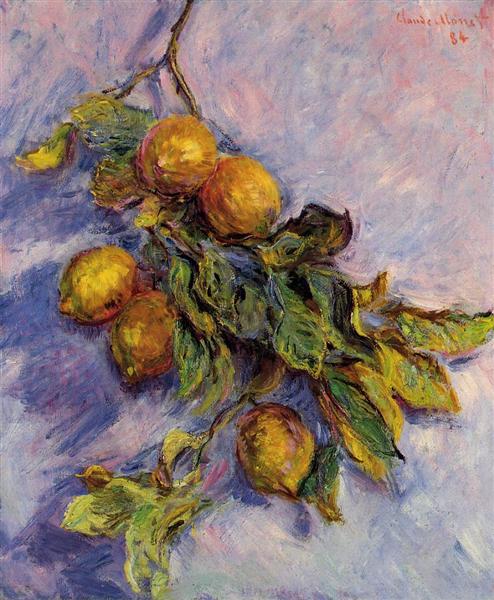Description
Claude Monet's painting "Branch of Lemons" (1884), a leading exponent of Impressionism, encapsulates the essence of nature in a fleeting and vibrant moment. In this work, Monet delves into the depiction of everyday elements with a mastery that resonates in his use of color and light, a hallmark of his style. The composition features a branch of lemons carefully arranged in a setting that evokes a deep connection with nature, characterized by immediacy and freshness.
Visually, the painting is dominated by a rich palette of yellow and gold hues that represent the luminosity of the lemons. These fruits hang from the branch with an almost ethereal glow, reflecting the light in a way that seems to project their juice and freshness. The greens of the leaves beautifully complement the yellows, creating a harmonious contrast and celebrating the vibrancy of the fruit. This interplay of colors offers a sense of immediacy, as if the viewer can almost feel themselves in the presence of the fresh scent of the citrus.
Monet's technique is particularly significant, wrapped in loose, dynamic brushstrokes that capture not only the shape, but also the light and atmosphere surrounding the lemons. This approach moves away from the rigidity of the academic art of his time and into a new world of visual impressions. Monet manages to make the surface of the canvas seem to vibrate; light and shadow play on the surface, creating a sense of movement and life. Through his splashes of colour, he gives the work an almost sensorial quality, drawing the viewer into a more intimate experience.
It is interesting to note that “Branch of Lemons” falls into a series of works Monet produced throughout his career where nature was a central theme. Although he often focused on larger landscapes, in this piece, the focus on a singular, specific object highlights his ability to see the greatness in the small. This work also aligns with Monet’s other contemporary creations, such as paintings of fruit and flowers, which explore the production of color and light in nature. Paintings such as “The Two Sisters” (Les Deux Sœurs) and “The Water Lily Pond” (Nymphéas) offer a complementary view of his exploration of light and the natural environment.
Furthermore, it is important to consider the temporal context of the work. In the late 19th century, perceptions of the natural world were changing, and Monet was a pioneer in capturing those changes in his work. This is seen not only in "Branch of Lemons," but throughout his body of work, where an interest in science, light, and the moment that defines Impressionism is evident.
Through “Branch of Lemons,” Monet not only presents a representation of nature but also reinvents the way art and beauty are perceived. One can feel the connection between the viewer and the ordered chaos of natural life, celebrating the ephemeral and the beautiful. This painting not only invites aesthetic contemplation but also prompts reflection on the relationship of human beings with their environment, a theme that is still relevant today. At its core, the work is a perfect manifestation of how art can capture not only the image, but also the emotion, the moment, and the experience of living.
KUADROS ©, a famous painting on your wall.
Hand-made oil painting reproductions, with the quality of professional artists and the distinctive seal of KUADROS ©.
Painting reproduction service with satisfaction guarantee. If you are not completely satisfied with the replica of your painting, we will refund 100% of your money.

